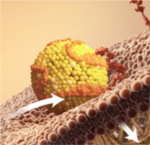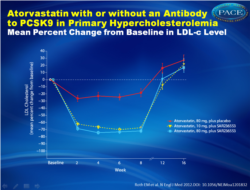PCSK9 inhibitor added to atorvastatin in primary hypercholesterolemia
26/11/2012
N Engl J Med. nov. 2012 . Does adding a monoclonal antibody to PCSK9 to low-dose atorvastatin lower cholesterol more effectively than atorvastatin alone?
Atorvastatin with or without an antibody to PCSK9 in primary hypercholesterolemia.Literature - Roth EM et al. N Engl J Med 2012.DOI: 10.1056/NEJMoa1201832
Roth EM, McKenney JM, Hanotin C, et al.
N Engl J Med. 2012;367:1891-900. doi: 10.1056/NEJMoa1201832.
Although statins are highly efficacious in lowering LDL cholesterol, many patients, especially those with very high initial LDL cholesterol levels and those who have unacceptable side effects with high-dose statins, do not reach recommended target levels of LDL cholesterol [1,2]. A considerable unmet medical need remains for additional, more effective therapeutic options that have acceptable side-effect profiles. Earlier this year, the findings of three phase 1 trials demonstrating the cholesterol-lowering effects of the drug in healthy volunteers and in people with familial or nonfamilial hypercholesterolemia were published [3].
In this study, 92 patients with LDL levels over 100 mg/dl despite taking atorvastatin 10 mg were studied. Patients were then randomized to 8 weeks of treatment with 80 mg atorvastatin plus the PCSK9 inhibitor SAR236553, 10 mg atorvastatin plus SAR236553, or 80 mg atorvastatin alone. SAR236553 was administered as an injection once every 2 weeks.
Reduction in LDL cholesterol from baseline:
SAR236553 may benefit patients in whom LDL cholesterol has not been reduced to recommended levels, either because of an inadequate lipid-lowering response with high-dose statins alone or because of unacceptable side effects with high-dose statins.
1. Waters DD, Brotons C, Chiang CW, et al. Lipid Treatment Assessment Project 2: a multinational survey to evaluate the proportion of patients achieving low-density lipoprotein cholesterol goals. Circulation 2009;120:28-34.
2. Ford ES, Li C, Pearson WS, et al. Trends in hypercholesterolemia, treatment and control among United States adults. Int J Cardiol 2010;140:226-35.
3. Stein EA, Mellis S, Yancopoulos GD, et al. Effect of a monoclonal antibody to PCSK9 on LDL cholesterol. N Engl J Med. 2012;366:1108-18.
Serum proprotein convertase subtilisin/kexin 9 (PCSK9) binds to low-density lipoprotein (LDL) receptors, increasing the degradation of LDL receptors and reducing the rate at which LDL cholesterol is removed from the circulation. REGN727/SAR236553 (designated here as SAR236553), a fully human PCSK9 monoclonal antibody, increases the recycling of LDL receptors and reduces LDL cholesterol levels.
Methods:
We performed a phase 2, multicenter, double-blind, placebo-controlled trial involving 92 patients who had LDL cholesterol levels of 100 mg per deciliter (2.6 mmol per liter) or higher after treatment with 10 mg of atorvastatin for at least 7 weeks. Patients were randomly assigned to receive 8 weeks of treatment with 80 mg of atorvastatin daily plus SAR236553 once every 2 weeks, 10 mg of atorvastatin daily plus SAR236553 once every 2 weeks, or 80 mg of atorvastatin daily plus placebo once every 2 weeks and were followed for an additional 8 weeks after treatment.
Results:
The least-squares mean (±SE) percent reduction from baseline in LDL cholesterol was 73.2±3.5 with 80 mg of atorvastatin plus SAR236553, as compared with 17.3±3.5 with 80 mg of atorvastatin plus placebo (P<0.001) and 66.2±3.5 with 10 mg of atorvastatin plus SAR236553. All the patients who received SAR236553, as compared with 52% of those who received 80 mg of atorvastatin plus placebo, attained an LDL cholesterol level of less than 100 mg per deciliter, and at least 90% of the patients who received SAR236553, as compared with 17% who received 80 mg of atorvastatin plus placebo, attained LDL cholesterol levels of less than 70 mg per deciliter (1.8 mmol per liter).
Conclusions:
In a randomized trial involving patients with primary hypercholesterolemia, adding SAR236553 to either 10 mg of atorvastatin or 80 mg of atorvastatin resulted in a significantly greater reduction in LDL cholesterol than that attained with 80 mg of atorvastatin alone.

A 3D video animation on the role of PCSK9 (with couresy of Amgen)
Advancing the Understanding of Cholesterol Metabolism:The Role of Proprotein Convertase Subtilisin-like/kexin Type 9 (PCSK9) in the Regulation of Low-Density Lipoprotein Cholesterol (LDL-C) and LDL Receptors (LDL-Rs) Read more...
N Engl J Med. 2012;367:1891-900. doi: 10.1056/NEJMoa1201832.
Background
Although statins are highly efficacious in lowering LDL cholesterol, many patients, especially those with very high initial LDL cholesterol levels and those who have unacceptable side effects with high-dose statins, do not reach recommended target levels of LDL cholesterol [1,2]. A considerable unmet medical need remains for additional, more effective therapeutic options that have acceptable side-effect profiles. Earlier this year, the findings of three phase 1 trials demonstrating the cholesterol-lowering effects of the drug in healthy volunteers and in people with familial or nonfamilial hypercholesterolemia were published [3].In this study, 92 patients with LDL levels over 100 mg/dl despite taking atorvastatin 10 mg were studied. Patients were then randomized to 8 weeks of treatment with 80 mg atorvastatin plus the PCSK9 inhibitor SAR236553, 10 mg atorvastatin plus SAR236553, or 80 mg atorvastatin alone. SAR236553 was administered as an injection once every 2 weeks.
Main results
Reduction in LDL cholesterol from baseline:- SAR236553 + atorvastatin 80 mg: 73.2% + 3.5
- SAR236553 + atorvastatin 10 mg: 66.2% + 3.5
- atorvastatin 80 mg: 17.3% + 3.5
Conclusion
SAR236553 may benefit patients in whom LDL cholesterol has not been reduced to recommended levels, either because of an inadequate lipid-lowering response with high-dose statins alone or because of unacceptable side effects with high-dose statins.
References
1. Waters DD, Brotons C, Chiang CW, et al. Lipid Treatment Assessment Project 2: a multinational survey to evaluate the proportion of patients achieving low-density lipoprotein cholesterol goals. Circulation 2009;120:28-34.2. Ford ES, Li C, Pearson WS, et al. Trends in hypercholesterolemia, treatment and control among United States adults. Int J Cardiol 2010;140:226-35.
3. Stein EA, Mellis S, Yancopoulos GD, et al. Effect of a monoclonal antibody to PCSK9 on LDL cholesterol. N Engl J Med. 2012;366:1108-18.
Abstract
Background:Serum proprotein convertase subtilisin/kexin 9 (PCSK9) binds to low-density lipoprotein (LDL) receptors, increasing the degradation of LDL receptors and reducing the rate at which LDL cholesterol is removed from the circulation. REGN727/SAR236553 (designated here as SAR236553), a fully human PCSK9 monoclonal antibody, increases the recycling of LDL receptors and reduces LDL cholesterol levels.
Methods:
We performed a phase 2, multicenter, double-blind, placebo-controlled trial involving 92 patients who had LDL cholesterol levels of 100 mg per deciliter (2.6 mmol per liter) or higher after treatment with 10 mg of atorvastatin for at least 7 weeks. Patients were randomly assigned to receive 8 weeks of treatment with 80 mg of atorvastatin daily plus SAR236553 once every 2 weeks, 10 mg of atorvastatin daily plus SAR236553 once every 2 weeks, or 80 mg of atorvastatin daily plus placebo once every 2 weeks and were followed for an additional 8 weeks after treatment.
Results:
The least-squares mean (±SE) percent reduction from baseline in LDL cholesterol was 73.2±3.5 with 80 mg of atorvastatin plus SAR236553, as compared with 17.3±3.5 with 80 mg of atorvastatin plus placebo (P<0.001) and 66.2±3.5 with 10 mg of atorvastatin plus SAR236553. All the patients who received SAR236553, as compared with 52% of those who received 80 mg of atorvastatin plus placebo, attained an LDL cholesterol level of less than 100 mg per deciliter, and at least 90% of the patients who received SAR236553, as compared with 17% who received 80 mg of atorvastatin plus placebo, attained LDL cholesterol levels of less than 70 mg per deciliter (1.8 mmol per liter).
Conclusions:
In a randomized trial involving patients with primary hypercholesterolemia, adding SAR236553 to either 10 mg of atorvastatin or 80 mg of atorvastatin resulted in a significantly greater reduction in LDL cholesterol than that attained with 80 mg of atorvastatin alone.

Role of PCSK9
In the regulation of LDL cholesterolA 3D video animation on the role of PCSK9 (with couresy of Amgen)
Advancing the Understanding of Cholesterol Metabolism:The Role of Proprotein Convertase Subtilisin-like/kexin Type 9 (PCSK9) in the Regulation of Low-Density Lipoprotein Cholesterol (LDL-C) and LDL Receptors (LDL-Rs) Read more...

